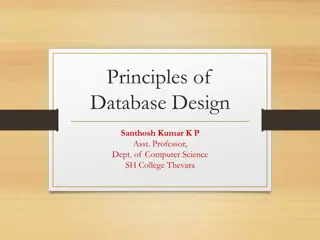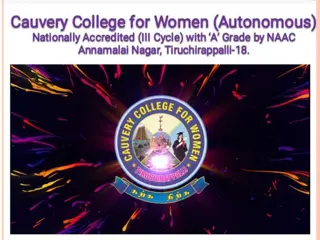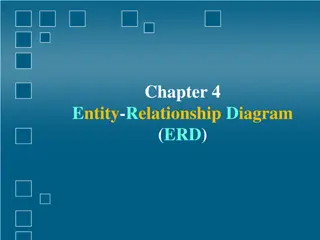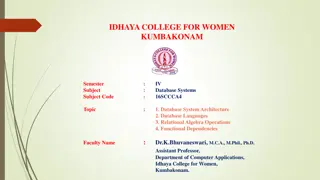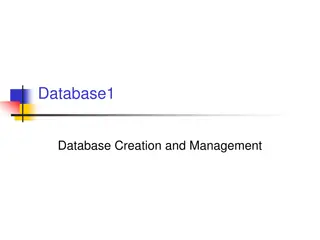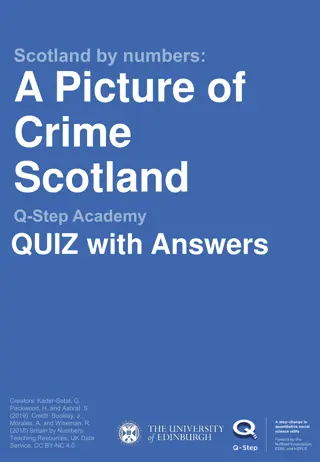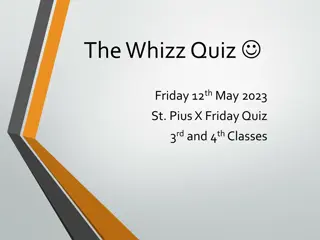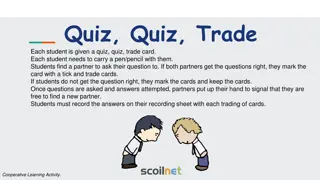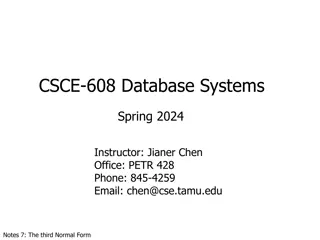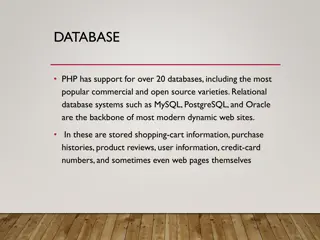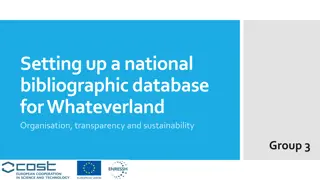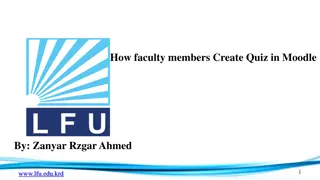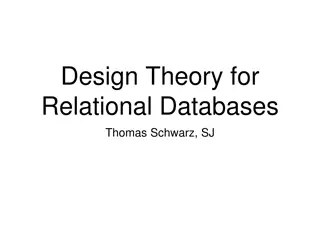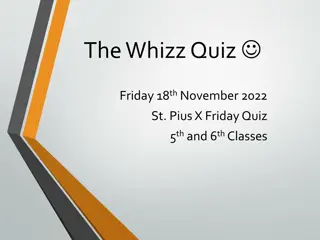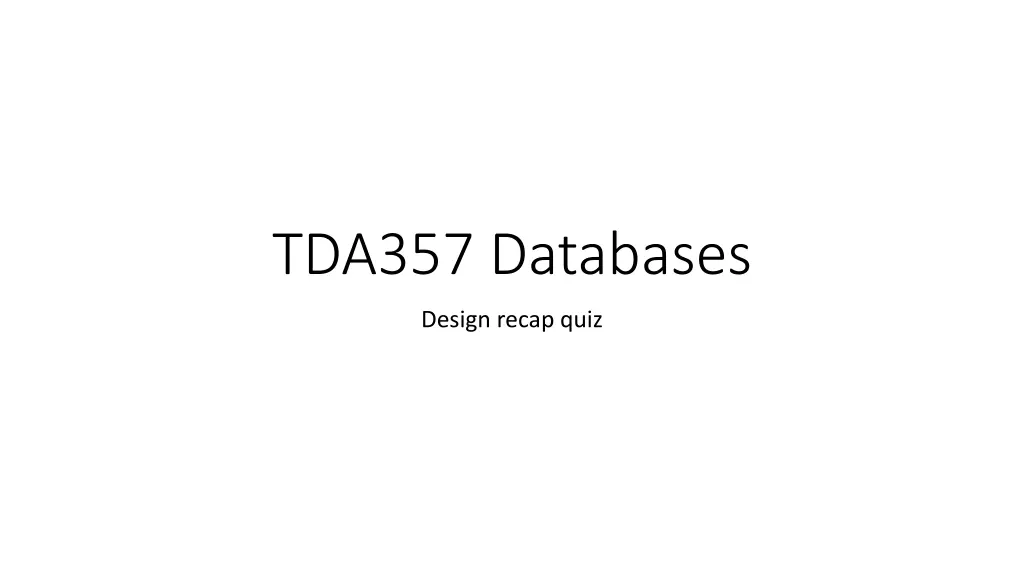
Database Design Recap Quiz
"Explore a database design recap quiz used in a TDA357/DIT620 lecture with questions ranging from ice cream consumption to ER diagrams. Test your knowledge on topics like team captains, player roles, and entity relationships."
Download Presentation

Please find below an Image/Link to download the presentation.
The content on the website is provided AS IS for your information and personal use only. It may not be sold, licensed, or shared on other websites without obtaining consent from the author. If you encounter any issues during the download, it is possible that the publisher has removed the file from their server.
You are allowed to download the files provided on this website for personal or commercial use, subject to the condition that they are used lawfully. All files are the property of their respective owners.
The content on the website is provided AS IS for your information and personal use only. It may not be sold, licensed, or shared on other websites without obtaining consent from the author.
E N D
Presentation Transcript
TDA357 Databases Design recap quiz
What is this? This quiz was used in the TDA357/DIT620 lecture on Wednesday 2016-11-09 8:00-10:00 Students participated using kahoot Part 1 (Questions 1-14 from this slide-deck, Questions 1 14 in kahoot) https://goo.gl/NsKEmt Part 2 (Questions 15-21 from this slide-desk, Questions 1-7 in kahoot): https://goo.gl/syOy36
Q5: Can a player be a captain without belonging to that team?
Q9: Draw the ER diagram A person has a name, birthday and SSN. Names and birthdays are not unique
A9 name name birthdate Person ssn Person ssn (A) (B) name birthdate name birthdate Person Person ssn ssn (C) (D)
Q10: Draw the ER diagram A person has a name, birthday and SSN. Names and birthdays are not unique A person can create many paintings but paintings are created by exactly one person
A10 name birthdate name birthdate name birthdate Person ssn Person ssn Person ssn Creates Creates Creates Painting Painting Painting (A) (B) (C)
Q11: Draw the ER diagram A person has a name, birthday and SSN. Names and birthdays are not unique A person can create many paintings but paintings are created by exactly one person People (a group of persons) can also own paintings
A11 Person Person Person Person Creates Creates Creates Creates Owns Owns owns owner Painting Painting Painting Painting (B) (C) (D) (A)
Q12: Draw the ER diagram A person has a name, birthday and SSN. Names and birthdays are not unique A person can create many paintings but paintings are created by exactly one person People (a group of persons) can also own paintings Only painters create paintings. Painters are people.
A12 Person Painter isPainter Painter Talent ISA Creates Person Person Owns Creates Creates Painting Owns Owns Painting Painting (C) (A) (B)
Q13: Create the relational scheme for the entities only
A13 person (id, name, address) car (license, year, model) accident (reportnum, date, location, personid, car) person (id, name, address) car (license, year, model) accident (reportnum, date, location) (A) (B) person (id, name, address) car (license, year, model, owner) accident (reportnum, date, location, personid, car) (C)
Q14: Create the relational scheme for the relationships only person (id, name, address) car (license, year, model) accident (reportnum, date, location)
A14 ownedBy(person, car) person -> Person.id car -> Car.license participated(person, car, accident, amount) person -> Person.id car -> Car.license accident -> Accident.reportnum ownedBy(person, car) person -> Person.id car -> Car.license participated(person, car, accident) person -> Person.id car -> Car.license accident -> Accident.reportnum (A) (B) ownedBy(person, car) person -> Person.id car -> Car.license participated(person, car, accident, amount) (person, car) -> ownedBy.(person, car) accident -> Accident.reportnum (C)
Q15: Create the relational scheme name birthdate Person ssn Creates name Painting
A15 Person(ssn, name, birthdate) Painting(name, painter) painter -> Person.ssn Person(ssn, name, birthdate) Painting(name) createdBy(work, painter) work -> Painting.name painter -> Person.ssn name birthdate Person ssn (A) (B) Creates Person(ssn, name, birthdate) Painting(name) createdBy(work, painter) work -> Painting.name painter -> Person.ssn Person(ssn, name, birthdate) Painting(name) createdBy(work, painter) work -> Painting.name painter -> Person.ssn name Painting (C) (D)
Q16: Create the relational scheme Person age ISA name Painter Owns value salary name Painting
A16 Person(name, age, salary) salary can be NULL Painting(name, value) ownedBy(work, painter) work -> Painting.name painter -> Person.name (B) Person(name, age) Painter(name, salary) name -> Person.name Painting(name, value) ownedBy(work, painter) work -> Painting.name painter -> Person.name (C) Person(name, age) Painter(name, age, salary) Painting(name, value) ownedBy(work, painter) work -> Painting.name painter -> Person.name (A) Person age ISA name Painter Owns value salary name Painting
Q17: calculate the closure of {a} R(a, b, c, d, e, f) a b a c c, d e, f b e {a}+= ?
Q18: which of these are superkeys of R? R(a, b, c, d, e, f) a b a c c, d e, f b e 1. {a} 2. {a, d} 3. {c, b, d} 4. {a, b, c, d, e, f}
Q19: what are the keys of R? R(a, b, c, d, e, f) a b a c c, d e, f b e c a, b 1. {a, d} 2. {a, c} 3. {a, d, c} 4. {c, d}
Q20: after splitting, how many non-trivial FDs in F+? R(a, b, c, d, e) a b, c b d d e
Q21: How many FDs or R are in BCNF? R(a, b, c, d) a b, c, d b, c a, d d b
Q22: Which FDs of R are in BCNF? R(a, b, c, d, e) a b, c (1) c d, e (2)
Q23: which BCNF decomposition is correct? R(a, b, c, d, e) a b, c c d, e R1(a, b, c) a b, c R2(d, e) d e (A) R1(a, b, c, d, e) a b, c R2(c) c -> R1.c (B) R1(a, b, c) a b, c R2(c, d, e) c d, e c -> R1.c (C)
Q24: which attribute of R is not prime? R(a, b, c, d) a, b c b d c a
Q25: Which FDs of R violate 3NF? R(a, b, c, d, e) a b, c, d, e (1) b, c a, d d e (2) (3)

